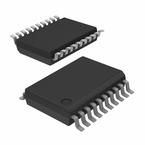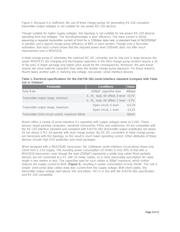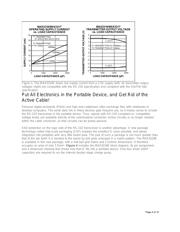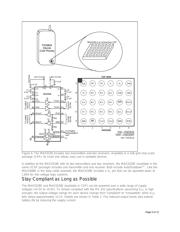Datasheet 搜索 > 接口芯片 > Maxim Integrated(美信) > MAX3218EAP+T 数据手册 > MAX3218EAP+T 其他数据使用手册 6/12 页

 器件3D模型
器件3D模型¥ 40.195
MAX3218EAP+T 其他数据使用手册 - Maxim Integrated(美信)
制造商:
Maxim Integrated(美信)
分类:
接口芯片
封装:
SSOP-20
Pictures:
3D模型
符号图
焊盘图
引脚图
产品图
页面导航:
技术参数、封装参数在P8
电气规格在P3P8
导航目录
MAX3218EAP+T数据手册
Page:
of 12 Go
若手册格式错乱,请下载阅览PDF原文件

For the V
CC
input, a built-in hysteresis of about 400mV prevents output-level changes when V
CC
is
noisy or subject to step changes in supply current. When V
CC
rises above approximately +3.5V, the
outputs return to RS-232-compliant levels. This feature allows the MAX3228E to be supplied from a
single Li+ cell. Thus, the MAX3228E provides fully compliant output-voltage swings while the battery is
fully charged. As the battery discharges, at some point the device switches automatically to RS-232-
compatible outputs, thereby ensuring operation of the serial port until the battery is fully discharged.
Table 2. Maxim transceivers automatically change to RS-232-compatible mode when their dual
charge pump no longer provides RS-232-compliant output voltages.
Transmitter Outputs
Parameter Conditions Min Typ Max
V
CC
Mode Switch Point (V
CC
Falling)
T_OUT changes from ±5V to
±3.7V
2.85V 3.1V
V
CC
Mode Switch Point (V
CC
Rising)
T_OUT changes from ±3.7V to
±5V
3.3V 3.7V
V
CC
Mode Switch Point Hysteresis 400mV
Output Voltage Swing
V
CC
= +3.1V to +5.5V,
V
CC
falling
V
CC
= +2.5V to +2.9V
±5V
±3.7V
±5.4V
Be Compatible, Not Compliant
The simple formula for saving power is to be compatible but not necessarily compliant with the RS-232
specification. To communicate over a short cable, it is not strictly necessary to comply with the 5V
output-voltage amplitude, because the receiver input thresholds are specified at +3V and –3V. A 2V drop
is unlikely in a short RS-232 cable! That condition appears to violate the RS-232 specification in Table
1, but consider an electrical specification that was created in the early nineties to be fully compatible with
the RS-232 specification.
Called EIA/TIA-562, it was invented to support serial data communications at lower supply voltages,
especially over short cables in quiet environments like offices, homes, and hotels. It targets
communications between battery-operated portable devices and computers. You can compare major
parameters in the EIA/TIA-562 specification of Table 1 with those in the RS-232 specification of Table
1sb in the sidebar. Neither spec defines a maximum cable length, but the EIA/TIA's maximum capacitive
load (1000pF) implies shorter cables than does the RS-232's 2500pF.
The EIA/TIA maximum-specified data rate is higher (60kbps), but 120kbps and above are already used
in many applications. The minimum transmitter-output amplitude (3.7V) is 1.3V below the RS-232
specification, and is compatible with quiet environments and a low voltage drop in the cable. Still, 3.7V
leaves a headroom of 700mV with respect to the specified receiver thresholds of +3V and –3V. Thus, an
RS-232 receiver has no problem in understanding signals from an EIA/TIA-562 transmitter.
The maximum output amplitude is rated 13.2V, but (as discussed earlier) the target is to save power by
operating the serial interface at the lowest possible voltage. In practice, actual receiver thresholds range
below +3V and above –3V. Though not specified, this fact provides another safety margin. The old quad-
receiver MC1489 has typical high and low receiver-input thresholds of 1.3V and 1.0V. The corresponding
MAX3225E thresholds are specified at 1.5V and 1.2V, as are those of other interface parts. Therefore,
the assumption that most positive thresholds are below 2.0V and negative thresholds above 0V allows an
additional voltage drop on the cable.
Typical Data-Cable Application
Page 6 of 12
器件 Datasheet 文档搜索
AiEMA 数据库涵盖高达 72,405,303 个元件的数据手册,每天更新 5,000 多个 PDF 文件






